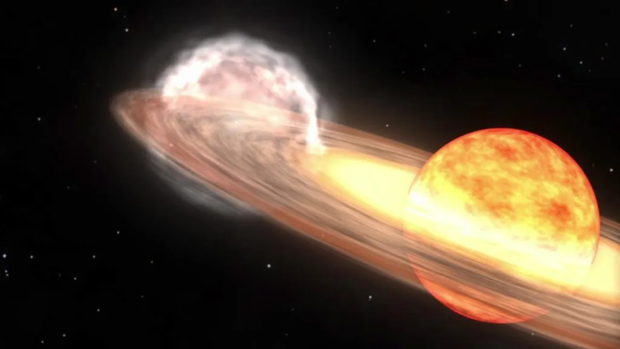Getting your Trinity Audio player ready...
A binary star system called T Coronae Borealis (T CrB), located approximately 3,000 light-years away in the constellation Corona Borealis, is expected to undergo a nova explosion between now and September 2024.
The nova explosion will cause T CrB to temporarily become as bright as Polaris, the North Star, for about a week, making it visible to the naked eye from the Northern Hemisphere.
1 View gallery


Illustration of a red giant in the lead-up to nova
(Photo: NASA/Conceptual Image Lab/Goddard Space Flight Center)
T CrB consists of an aging red giant star and a white dwarf companion, where the white dwarf is feeding on the red giant's outer atmosphere, leading to a thermonuclear explosion roughly every 80 years.
The last nova explosion from T CrB visible from Earth occurred in 1946, making this an extremely rare and once-in-a-lifetime event.
The nova explosion is caused by hydrogen accretion from the red giant onto the surface of the white dwarf, resulting in a thermonuclear explosion that blasts away the accreted material.
Recurrent novae events like T CrB offer valuable insights into mass transfer between stars and the processes leading to a nova eruption.
New tools like gamma-ray imagers and IXPE's polarization capabilities will provide insights into binary systems and stellar processes, but the behavior of recurrent novae like T CrB can be unpredictable, with no guarantees of an exact eruption date.
NASA and astronomers worldwide are preparing to study the T CrB nova explosion with ground and space-based instruments to understand the physical processes and dynamics of such events.
NASA recommends staying updated through social media and email for instant alerts about the T CrB nova event, which is expected to spark interest in astronomy for many people.
This article was written in collaboration with Generative AI news company Alchemiq
Sources: CNN, BBC, Forbes, Yahoo News, NASA, Digital Trends, Mirror, News Bytes App, Economic Times, Head Topics, ZME Science, Indy100, Metro, News9 Live, LadBible, NewsNation Now, and ITV.

